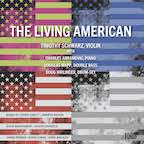Timothy Schwarz
The Living American
Albany Records
Violinist Timothy Schwarz has commissioned, performed, and recorded a number of pieces by contemporary composers. His latest release on Albany, The Living American, is a collection of recent pieces by American composers.
Schwarz takes a “melting pot” approach to his program. It opens with the solo Fantasy on Lama Badaa yatsana, written by Stephen Sametz, which explores alternate scales with frequent double-stops and harmonics alongside virtuosic melodic writing. Pianist Charles Abramovic joins Schwarz on a set of pieces by musical theater composer Joseph Goodrich. Indeed, C-minor Jam leans much closer to a theatrical version of jazz than one by legit jazzers, but it is an entertaining romp nonetheless. Goodrich’s Lacrimosa is a touching, lyrical work with, as one would suspect, a mournful cast. Schwarz plays emotively, phrasing the music expansively with a variety of textures. The Machine is a syncopated moto perpetuo, with the piano playing a punctilious ostinato in the bass that is countered by one in the violin with equal verve.
Jennifer Higdon’s String Poetic: Blue Hills of Mist, opens with inside-the-piano work alongside chords to create a swath of overtones. The violin joins with a soaring line that encompasses some of the notes from the piano, adding weight to the overtones. The piano then plays a brooding, mournful accompaniment and the violin counters with a tender, modal melody. Schwarz and Abramovic make an excellent performing pair on this sumptuous work. A warmly hued cadenza accompanied by percussive dampened piano strings follows. The piano plays color chords and the violin once again begins a cadenza, taking stops along the way for sustained notes. The coda ensues, with percussive piano mirroring notes in the violin. A pizzicato note provides a final pitch that is quite a surprise.
The beginning of Jessie Montgomery’s Rhapsody No. 2 is filled with challenging scalar runs that traverse the entire compass of the instrument. A slow section of harmonics adds a more dissonant harmonic palette. Gradually, a slowed down version of the opening scalar passages, with yearning high notes, takes over. Double stops appear in a speeding up crescendo. The opening gesture returns in a valedictory flourish.
Reena Esmail’s musical approach combines Eastern and Western elements. This synthesis is abundantly apparent in the solo piece Darshan: Raag charukeshi. Once again, Schwarz is adept at dealing with the requirements of multiple technical approaches. His playing carefully negotiates the microtones and sliding techniques of Esmail’s piece.
Avner Dorman’s Sonata No. 2 for Violin and Piano begins with a slow boil of angular violin gestures. This is joined by the piano, which plays clouds of harmonies against dissonant leaps in the violin. Multi-stopped passages and yearning melodies are accompanied by enigmatic arpeggiations in the piano. A second section begins with strident harmonics and bass-register piano punctuations. The piano quickens into a brusk ostinato, over which the violin performs aggressive turns through glissandos and slashed multi-stops. The duo build to a ferocious climax, dizzying in intensity. A gradual slowdown concludes with a brief violin solo. Soft, pointillist piano lines abets a low register violin melody that gradually slides up its compass, adding double-stops. A glissando buzzes down to scordatura bass notes, then makes wave shaped lines that continue in a slippery path to silence.
The final work on the recording is a five-movement piece called Australian Sketches. I am puzzled as to why this is included on The Living American. True, the composer Denis Deblasio, is a jazz composer from the US, but why have the longest programmed work be an homage to Australia? If one sets aside this programmatic puzzlement, the music is a real treat. Schwarz and Abramovic are joined by bassist Douglas Mapp, and drummer Doug Hirlinger in a cabaret combo. Like C-minor Jam, this is jazz in a pop context. I am reminded of Stefan Grappelli’s film work (such as his featured role on the Dirty Rotten Scoundrels soundtrack) in Schwarz’s approach to Deblasio’s effervescent creations. The performances are playfully rendered, but artful as well. Given the melting pot approach already in evidence, on second thought, why not invite our friends from Australia to join in the fun?
-Christian Carey

